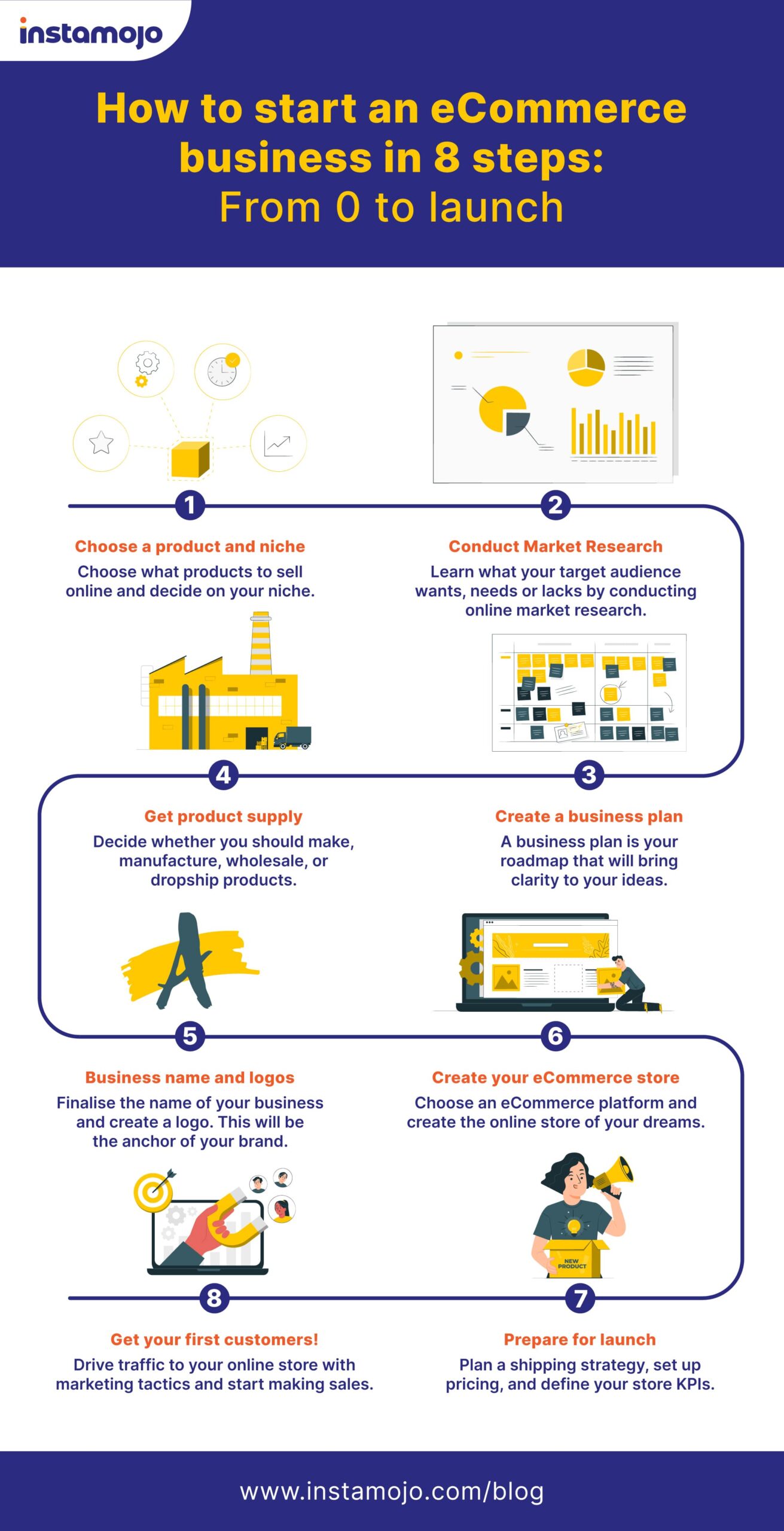Launch Your E-commerce Store in India: The Ultimate Guide

The India E-Commerce Market size is estimated at USD 112.93 billion in 2024, and is expected to reach USD 299.01 billion by 2029, growing at a CAGR of 21.5% during the forecast period (2024-2029). One of the primary factors driving the market’s growth is rapid urbanization.
India’s huge and still-expanding base of internet users includes increasing penetration into the rural market. This promises a bright future for e-commerce. Whether purchasing e-tickets from Indian Railways or fast-moving consumer goods (FMCG) and other lifestyle products, consumers have started getting accustomed to the online platform, which enables easier transactions and delivery at the preferred location.
E-commerce Business in India: Your Ultimate Guide to Success
Table of Contents
- Introduction: Demystifying E-commerce
- What is E-commerce?
- What is E-commerce?
- Types of E-commerce Businesses
- Benefits of Launching an E-commerce Business in India
- Finding Your Niche: The Foundation of Your E-commerce Journey
- Charting Your Course: A Step-by-Step Guide to E-commerce Success
- Step 1: Refine Your Business Idea
- Step 2: Develop a Compelling Business Plan
- Step 3: Source High-Quality Products
- Step 4: Craft a User-Friendly Online Store
- Step 5: Implement Effective Marketing Strategies
- Step 6: Prioritize Customer Satisfaction
- E-commerce Success in India: A Final Note
- Additional Tips for Aspiring E-commerce Entrepreneurs
- Conclusion
Introduction: Demystifying E-commerce
The world of commerce is undergoing a significant transformation. Gone are the days when physical stores were the sole avenue for buying and selling goods. E-commerce, or electronic commerce, has revolutionized the way we shop, offering a convenient and accessible alternative.
In simpler terms, e-commerce eliminates the need for brick-and-mortar stores. It’s the seamless buying and selling of goods and services conducted entirely online. Imagine a platform where customers browse and purchase products through websites or online marketplaces, with transactions processed securely.
E-commerce encompasses various models, catering to different needs:
Business-to-Consumer (B2C): Businesses directly sell products or services to individual consumers. Think popular online apparel stores or electronics retailers.
Business-to-Business (B2B): Businesses connect and conduct transactions with other businesses. This could involve raw material suppliers or finished product wholesalers.
Consumer-to-Consumer (C2C): Individuals sell products or services to other consumers. Online marketplaces facilitating used good sales are prime examples.
Benefits of Launching an E-commerce Business in India
The e-commerce landscape offers a multitude of advantages for aspiring Indian entrepreneurs:
Global Reach: Unlike brick-and-mortar stores limited by location, your online store transcends geographical boundaries. You can attract customers from across India and even internationally.
Reduced Overhead Costs: Forget hefty rent payments or the need for a large physical staff. E-commerce allows you to operate with a leaner structure, minimizing your initial investment.
Scalability: As your business flourishes, it’s easy to scale your e-commerce operations. You can expand your product offerings or cater to a growing customer base without significant physical constraints.
Convenience for Customers: The ability to shop anytime, anywhere is a major perk for today’s consumers. Your e-commerce store offers 24/7 accessibility, catering to busy schedules and preferences.
Finding Your Niche: The Cornerstone of Your Success
A well-defined niche is crucial for your e-commerce venture. It helps you target a specific customer base and tailor your offerings to their unique needs. Here are pointers to refine your niche selection:
- Identify your passions and expertise. What are you knowledgeable and enthusiastic about?
- Research market trends. Are there unmet consumer needs or growing product categories? Conduct thorough research to validate your product concept and understand market demand. Tools like Google Keyword Planner can help you assess search volume for relevant keywords.
- Analyze your competition. How can you differentiate yourself from existing players in the market?
Charting Your Course: A Step-by-Step Guide to E-commerce Success
Launching a successful e-commerce business in India requires meticulous planning and execution. Here’s a roadmap to guide you:
- Refine Your Business Idea
- Develop a Compelling Business Plan
- Source High-Quality Products
- Craft a User-Friendly Online Store
- Implement Effective Marketing Strategies
- Prioritize Customer Satisfaction

1. Researching Your E-commerce Business Idea
Validating your e-commerce business idea is a crucial first step before diving into planning and execution. Here are some effective research methods to equip you with the knowledge you need to make informed decisions:
1. Market Research: Understanding Your Target Audience and Landscape
- Secondary Research: Leverage existing data and reports to gain insights into your target market and industry trends. Here are some resources:
- Government Resources: The Indian government provides valuable data through sources like the Office of the Registrar General & Census Commissioner of India (https://censusindia.gov.in/) and Department of Industrial Policy and Promotion (https://www.mygov.in/group/department-industrial-policy-and-promotion-dipp/). These can offer insights into demographics, consumer spending patterns, and industry outlooks.
- Industry Reports: Market research firms like Statista and IBEF (India Brand Equity Foundation) publish industry reports providing valuable data and analysis on specific sectors. Consider reports on e-commerce in India or your chosen niche.
- E-commerce Platforms: Established e-commerce platforms like Amazon and Flipkart often publish seller resources and data insights that can be informative.
- Primary Research: Conduct your own research to gather firsthand information about your target audience and their needs:
-
- Surveys and Questionnaires: Develop online surveys or questionnaires to collect data from potential customers about their shopping habits, preferences, and pain points. Tools like Google Forms: can be helpful for creating and distributing surveys.
- Interviews: Conduct in-depth interviews with potential customers to gain a deeper understanding of their motivations, challenges, and buying decisions.
-
2. Competitive Analysis: Learning from the Game Changers
- Identify your key competitors in the Indian e-commerce market, both direct and indirect.
- Analyze their websites, product offerings, marketing strategies, pricing models, customer reviews, and social media presence.
- Look for gaps in their offerings or areas where you can differentiate your brand. Tools like Similarweb: [[invalid URL removed]] can provide website traffic data and insights into competitor strategies.
3. Market Validation: Testing the Waters of Demand
- Minimum Viable Product (MVP): Develop a basic version of your product or service to test its appeal with potential customers. This could be a prototype, a limited product offering, or even a pre-order campaign. Gathering feedback at this stage can help you refine your concept before full-scale launch.
- Social Media Engagement: Utilize social media platforms like Facebook and Instagram to create a buzz around your brand and engage with potential customers. Gauge their interest in your product idea and gather feedback through polls, questions, and discussions.
2. E-commerce Business Plan in India
A compelling business plan secures funding and guides your e-commerce journey. Here’s a concise breakdown of the key elements:
- Executive Summary
- Business Description:
- Market Analysis:
- Marketing & Sales Strategy:
- Operations Plan:
- Management & Organization:
- Financial Projections:
3. Source high quality products
- Define Your Needs: What are you selling? What quality standards matter?
- Explore Channels: Look for suppliers on B2B platforms, industry associations, trade shows, or directories.
- Evaluate Suppliers: Shortlist promising options, request quotes & samples, check backgrounds.
- Negotiate & Agree: Negotiate terms, set quality control measures, and finalize a contract.
Bonus Tip: Build long-term relationships with ethical suppliers for better deals in the future.
4. User-Friendly E-commerce Store for India
Search for a good ecommerce development company in india who work on quality
- Products: High-quality images, detailed descriptions, customer reviews.
- Checkout: Streamlined process, multiple payment options (UPI!), guest checkout, clear shipping costs.
- Mobile: Mobile-first design, fast loading times, touch-friendly interface.
Bonus Tips: Live chat support, multilingual option (Hindi?), FAQ section.
5. Implement Effective Marketing Strategies
- SEO: Optimize website & content for relevant keywords (target Indian searches).
- Social Media: Engage on popular platforms (Instagram, Facebook) with relevant social content.
- Targeted Ads (Optional): Consider paid advertising on social media or search engines to reach a wider audience.
- Email Marketing: Build an email list for targeted promotions and updates.
Customer Satisfaction:
- Live Chat Support: Offer real-time assistance for quick issue resolution.
- Returns & Refunds: Make returns/refunds easy and hassle-free (build trust).
- Order Tracking: Provide clear order tracking options to keep customers informed.
- Post-Purchase Communication: Follow up with surveys or emails to gather feedback and address any concerns.
Bonus Tip: Loyalty Programs: Reward repeat customers for their business (encourage retention).
E-commerce Success in India: A Final Note
The e-commerce industry in India is experiencing phenomenal growth. By following this guide and leveraging the immense potential of online retail, you can turn your entrepreneurial dreams into a thriving e-commerce business. Remember, success hinges on continuous learning, adaptation, and a commitment to providing exceptional customer value.
Additional Tips for Aspiring E-commerce Entrepreneurs
Start by Making your brand store online: Hire an ecommerce web development company that will help you create a branded store online on platforms like Shopify, WooCommerce, Magento, or through custom development based on your requirements
Leverage E-commerce Platforms: Consider utilizing established platforms like Amazon Business to gain access to a wider customer base and benefit from their streamlined infrastructure. These platforms can handle aspects like payment processing, logistics, and customer service, allowing you to focus on product sourcing, marketing, and brand building.
Stay Compliant with Regulations: Familiarize yourself with e-commerce regulations in India, including tax requirements (like GST) and data privacy laws (like GDPR). Ensuring compliance protects your business and builds trust with your customers.
Embrace Mobile Commerce: Optimize your website for mobile devices, as a significant portion of online shopping occurs on smartphones. This means ensuring your website has a responsive design that adapts to different screen sizes and offers a smooth user experience on mobile devices.
Conclusion
The e-commerce landscape in India presents a golden opportunity for aspiring entrepreneurs. By following the steps outlined in this guide, staying informed about industry trends, and prioritizing exceptional customer service, you can establish a prominent online presence and carve your niche in the thriving Indian e-commerce market. Remember, the journey to e-commerce success is an ongoing process. Embrace continuous learning, adapt to evolving consumer preferences, and never stop innovating to stay ahead of the curve. With dedication and a strategic approach, you can turn your e-commerce dream into a flourishing reality.
CTA Section
Looking to create an ecommerce website that builds trust, captivates visually, and drives conversions? If you’re in Mumbai, India, and need a custom Shopify design and development solution, your search ends here! Our team of expert Shopify developers in Mumbai, India, is ready to transform your ecommerce vision into reality. Get in touch with us today for a complimentary consultation!
More Related Links
Building Your Dream Store: A Guide to Shopify Website Development
Ecommerce Product Page Anatomy
14 must-have features for your e-commerce website
About Author
 Meet Ritu, an expert writer in Shopify, ecommerce, and web development. Her articles provide insightful guidance navigating the online retail and web technology landscapes.
Meet Ritu, an expert writer in Shopify, ecommerce, and web development. Her articles provide insightful guidance navigating the online retail and web technology landscapes.







